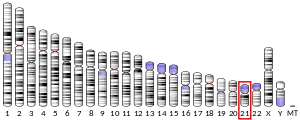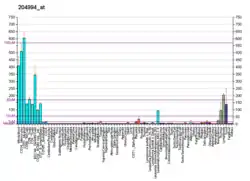Interferon-induced GTP-binding protein Mx2 is a protein that in humans is encoded by the MX2 gene.[3][4][5]
The protein encoded by this gene has a nuclear and a cytoplasmic form and is a member of both the dynamin family and the family of large GTPases. The nuclear form is localized in a granular pattern in the heterochromatin region beneath the nuclear envelope. A nuclear localization signal (NLS) is present at the amino terminal end of the nuclear form but is lacking in the cytoplasmic form due to use of an alternate translation start codon.
Antiviral activity
This protein is upregulated by interferon-alpha but does not contain the antiviral activity of a similar myxovirus resistance protein 1.[5]
MX2/MXB has antiviral activity against HIV-1.[6][7][8][9][10][11][12] MXB is also a restriction factor for herpesviruses, which acts at a very early stage of the replication cycle and MX2/MXB restriction of herpesvirus requires GTPase activity.[13][14][15][16]
References
- 1 2 3 GRCh38: Ensembl release 89: ENSG00000183486 - Ensembl, May 2017
- ↑ "Human PubMed Reference:". National Center for Biotechnology Information, U.S. National Library of Medicine.
- ↑ Aebi M, Fäh J, Hurt N, Samuel CE, Thomis D, Bazzigher L, et al. (November 1989). "cDNA structures and regulation of two interferon-induced human Mx proteins". Molecular and Cellular Biology. 9 (11): 5062–72. doi:10.1128/mcb.9.11.5062. PMC 363658. PMID 2481229.
- ↑ Melén K, Keskinen P, Ronni T, Sareneva T, Lounatmaa K, Julkunen I (September 1996). "Human MxB protein, an interferon-alpha-inducible GTPase, contains a nuclear targeting signal and is localized in the heterochromatin region beneath the nuclear envelope". The Journal of Biological Chemistry. 271 (38): 23478–86. doi:10.1074/jbc.271.38.23478. PMID 8798556.
- 1 2 "Entrez Gene: MX2 myxovirus (influenza virus) resistance 2 (mouse)".
- ↑ Liu Z, Pan Q, Ding S, Qian J, Xu F, Zhou J, et al. (October 2013). "The interferon-inducible MxB protein inhibits HIV-1 infection". Cell Host & Microbe. 14 (4): 398–410. doi:10.1016/j.chom.2013.08.015. PMID 24055605.
- ↑ Kane M, Yadav SS, Bitzegeio J, Kutluay SB, Zang T, Wilson SJ, et al. (October 2013). "MX2 is an interferon-induced inhibitor of HIV-1 infection". Nature. 502 (7472): 563–6. Bibcode:2013Natur.502..563K. doi:10.1038/nature12653. PMC 3912734. PMID 24121441.
- ↑ Goujon C, Moncorgé O, Bauby H, Doyle T, Ward CC, Schaller T, et al. (October 2013). "Human MX2 is an interferon-induced post-entry inhibitor of HIV-1 infection". Nature. 502 (7472): 559–62. Bibcode:2013Natur.502..559G. doi:10.1038/nature12542. PMC 3808269. PMID 24048477.
- ↑ Alvarez FJ, He S, Perilla JR, Jang S, Schulten K, Engelman AN, et al. (September 2017). "CryoEM structure of MxB reveals a novel oligomerization interface critical for HIV restriction". Science Advances. 3 (9): e1701264. Bibcode:2017SciA....3E1264A. doi:10.1126/sciadv.1701264. PMC 5600524. PMID 28929138.
- ↑ Merindol N, Berthoux L (2015). "Restriction Factors in HIV-1 Disease Progression". Current HIV Research. 13 (6): 448–61. doi:10.2174/1570162x13666150608104412. PMID 26051387.
- ↑ Haller O, Staeheli P, Schwemmle M, Kochs G (March 2015). "Mx GTPases: dynamin-like antiviral machines of innate immunity". Trends in Microbiology. 23 (3): 154–63. doi:10.1016/j.tim.2014.12.003. PMID 25572883.
- ↑ Chintala K, Mohareer K, Banerjee S (2021). "Dodging the Host Interferon-Stimulated Gene Mediated Innate Immunity by HIV-1: A Brief Update on Intrinsic Mechanisms and Counter-Mechanisms". Frontiers in Immunology. 12: 716927. doi:10.3389/fimmu.2021.716927. PMC 8358655. PMID 34394123.
- ↑ Crameri M, Bauer M, Caduff N, Walker R, Steiner F, Franzoso FD, et al. (May 2018). "MxB is an interferon-induced restriction factor of human herpesviruses". Nature Communications. 9 (1): 1980. Bibcode:2018NatCo...9.1980C. doi:10.1038/s41467-018-04379-2. PMC 5958057. PMID 29773792.
- ↑ Schilling M, Bulli L, Weigang S, Graf L, Naumann S, Patzina C, et al. (September 2018). Sandri-Goldin RM (ed.). "Human MxB Protein Is a Pan-herpesvirus Restriction Factor". Journal of Virology. 92 (17): e01056–18, /jvi/92/17/e01056–18.atom. doi:10.1128/JVI.01056-18. PMC 6096802. PMID 29950411.
- ↑ Jaguva Vasudevan AA, Bähr A, Grothmann R, Singer A, Häussinger D, Zimmermann A, Münk C (September 2018). "MXB inhibits murine cytomegalovirus". Virology. 522: 158–167. doi:10.1016/j.virol.2018.07.017. PMID 30032029.
- ↑ Staeheli P, Haller O (December 2018). Ulrike Gack MU (ed.). "Human MX2/MxB: a Potent Interferon-Induced Postentry Inhibitor of Herpesviruses and HIV-1". Journal of Virology. 92 (24): e00709–18, /jvi/92/24/e00709–18.atom. doi:10.1128/JVI.00709-18. PMC 6258936. PMID 30258007.
Further reading
- Horisberger MA, McMaster GK, Zeller H, Wathelet MG, Dellis J, Content J (March 1990). "Cloning and sequence analyses of cDNAs for interferon- and virus-induced human Mx proteins reveal that they contain putative guanine nucleotide-binding sites: functional study of the corresponding gene promoter". Journal of Virology. 64 (3): 1171–81. doi:10.1128/JVI.64.3.1171-1181.1990. PMC 249231. PMID 2154602.
- Horisberger MA, Wathelet M, Szpirer J, Szpirer C, Islam Q, Levan G, et al. (March 1988). "cDNA cloning and assignment to chromosome 21 of IFI-78K gene, the human equivalent of murine Mx gene". Somatic Cell and Molecular Genetics. 14 (2): 123–31. doi:10.1007/BF01534397. PMID 3162334. S2CID 31805827.
- al-Masri AN, Werfel T, Jakschies D, von Wussow P (February 1997). "Intracellular staining of Mx proteins in cells from peripheral blood, bone marrow and skin". Molecular Pathology. 50 (1): 9–14. doi:10.1136/mp.50.1.9. PMC 379572. PMID 9208807.
- Melén K, Julkunen I (December 1997). "Nuclear cotransport mechanism of cytoplasmic human MxB protein". The Journal of Biological Chemistry. 272 (51): 32353–9. doi:10.1074/jbc.272.51.32353. PMID 9405443.
- Hattori M, Fujiyama A, Taylor TD, Watanabe H, Yada T, Park HS, et al. (May 2000). "The DNA sequence of human chromosome 21". Nature. 405 (6784): 311–9. Bibcode:2000Natur.405..311H. doi:10.1038/35012518. PMID 10830953.
- Strausberg RL, Feingold EA, Grouse LH, Derge JG, Klausner RD, Collins FS, et al. (December 2002). "Generation and initial analysis of more than 15,000 full-length human and mouse cDNA sequences". Proceedings of the National Academy of Sciences of the United States of America. 99 (26): 16899–903. Bibcode:2002PNAS...9916899M. doi:10.1073/pnas.242603899. PMC 139241. PMID 12477932.
- Rual JF, Venkatesan K, Hao T, Hirozane-Kishikawa T, Dricot A, Li N, et al. (October 2005). "Towards a proteome-scale map of the human protein-protein interaction network". Nature. 437 (7062): 1173–8. Bibcode:2005Natur.437.1173R. doi:10.1038/nature04209. PMID 16189514. S2CID 4427026.
- Tanaka S, Honda Y, Honda M (August 2007). "Identification of differentially expressed genes in blood cells of narcolepsy patients". Sleep. 30 (8): 974–9. doi:10.1093/sleep/30.8.974. PMC 1978392. PMID 17702266.


